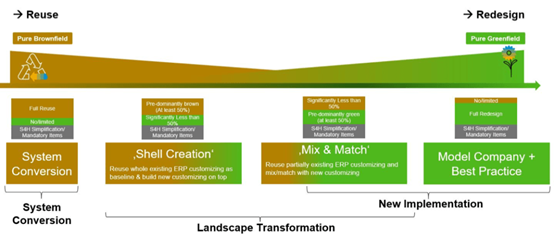HAND Global Solutions (HAND) is a leading Enterprise IT Solutions Service Provider, committed to provide enterprise with holistic, stable, agile, integrated, one-stop digital transformation with SaaS(Software as a Service) and platform solution.
HAND's service scope has expanded to the overall enterprise information application, SaaS, consulting, implementation and technical support services.

Greenfield implementation:
In the case of SAP S/4HANA implementations, greenfield means untouched by previous developments.
Without a doubt, a greenfield implementation is the easiest way to get started with SAP S/4HANA. With greenfield, you can just sweep aside this unsortable, non-upgradable mess and start all over again.
There’s also a business reason why a greenfield approach is often favoured. Businesses are never static – chances are that your business organization has changed over time, and you used to rely on processes that aren’t valid anymore. Maybe you’ve shifted from providing goods to offering services, or your geographical footprint has been restructured. In the case of a company with multiple sites, a greenfield implementation can be approached in a phased way. However, you’ll need temporary solutions for intercompany movements and possibly parallel systems running at the same time.
However, your company will also “lose” its historical data. It takes some thinking ahead to maintain access to this data and to ensure legal compliance.
Brownfield implementation:
Think of a car. It’s a little far-fetched, but imagine needing a full engine replacement. You still have the same car with the same history and the same mileage, the same look and feel, etc. Nothing changes for the driver other than performance improvements. Of course, you can take it a step further and add a completely new dash that displays more information in a better, more intuitive way.
This analogy corresponds to a brownfield migration of SAP S/4HANA that includes SAP’s innovative new interface, SAP Fiori. Users can use the same GUI interfaces they’ve relied on for years or choose to embrace Fiori, which introduces a lot of benefits and added value.
The pros of a brownfield migration are less costly since the things that work well for your company don’t have to be rebuilt from scratch. Some customers choose small technical refinements of existing functionality and apps, but the migration is a lot lighter. You also get to take your master data with you without having to extract and load it into an entirely new system – it all happens automatically during the migration.
The main issue with a brownfield migration is that it must be done all at once, known colloquially as a “big bang”. If your company has a limited tolerance for downtime, a brownfield can be difficult. And while the migrated system includes the full scope of SAP S/4HANA advantages, you can’t drastically overhaul the way you have set up your system. The modern way of implementing keeps the core ‘clean’ – developments are executed on a specific platform and not in the core. It’s important to note that applying this approach to a migration requires quite a bit of rework, but it could be done in a second phase.”
Hybrid implementation:
We make a perfect copy of a customer’s existing system and remove their data from it, keeping the configurations and custom development efforts, and migrate it to SAP S/4HANA. The migration itself is easier since it allows you to make changes to your configurations. But you always must load the data again – that’s a big disadvantage.
If a company really needs to make core changes to its environment, a hybrid approach is suitable. This is because they get to reuse a lot of things you’ve built, and you avoid the longer downtime inherent to a brownfield migration. Since the new system is running in parallel with the old one, there’s a cutover time of a couple hours rather than a few days.
No one-size-fits-all when it comes to SAP S/4HANA implementations
A company’s industry, organization, and history, as well as the structure of its IT environment, are major factors influencing its ideal path to SAP S/4HANA.
For example, moving from an ECC system to a greenfield S/4HANA system will not be drastically different for users. This may be a different story if you’re moving from a legacy system like AS400 to SAP. Even so, there are still ways to preserve familiar ways of working.
CLICK HERE to view the detailed user guide for more information. For more information about the product, please visit the Product Page. Explore Hand Global Solutions Pte. Ltd.'s Store
Visit Hand Global Solutions Pte. Ltd.'s shop to find a range of tailored products that can enhance your experience and meet your needs.
Explore Hand Global Solutions Pte. Ltd.'s Store
Visit Hand Global Solutions Pte. Ltd.'s shop to find a range of tailored products that can enhance your experience and meet your needs.



